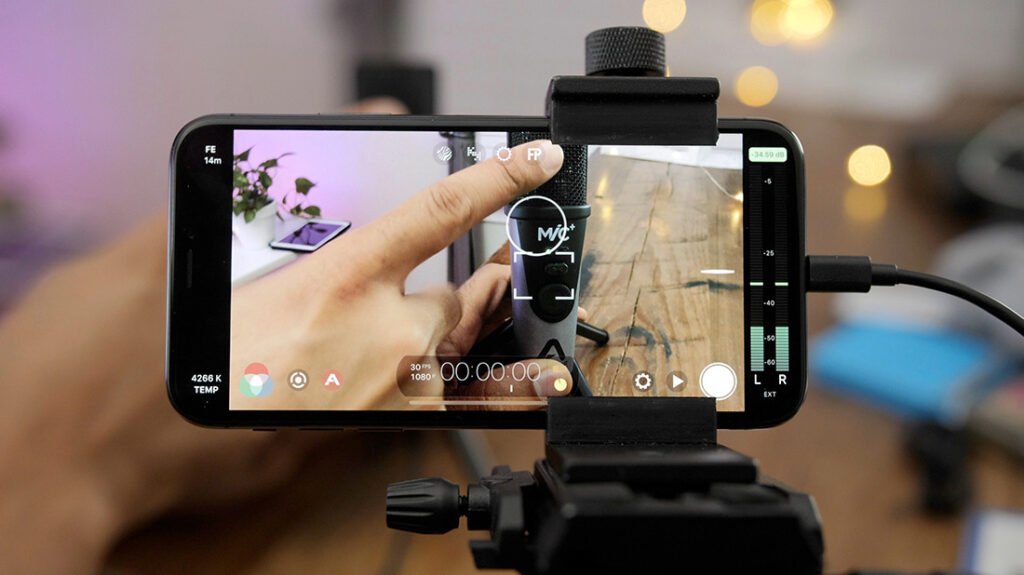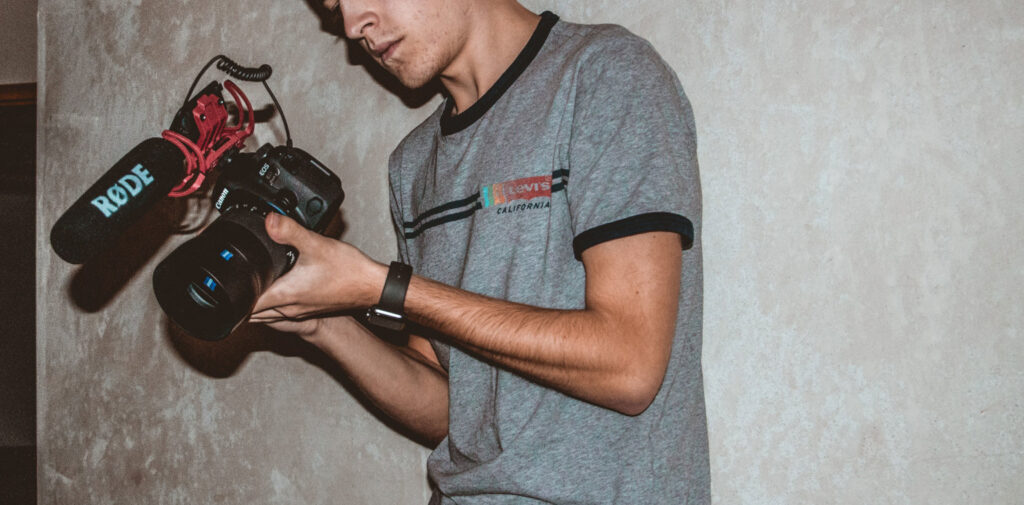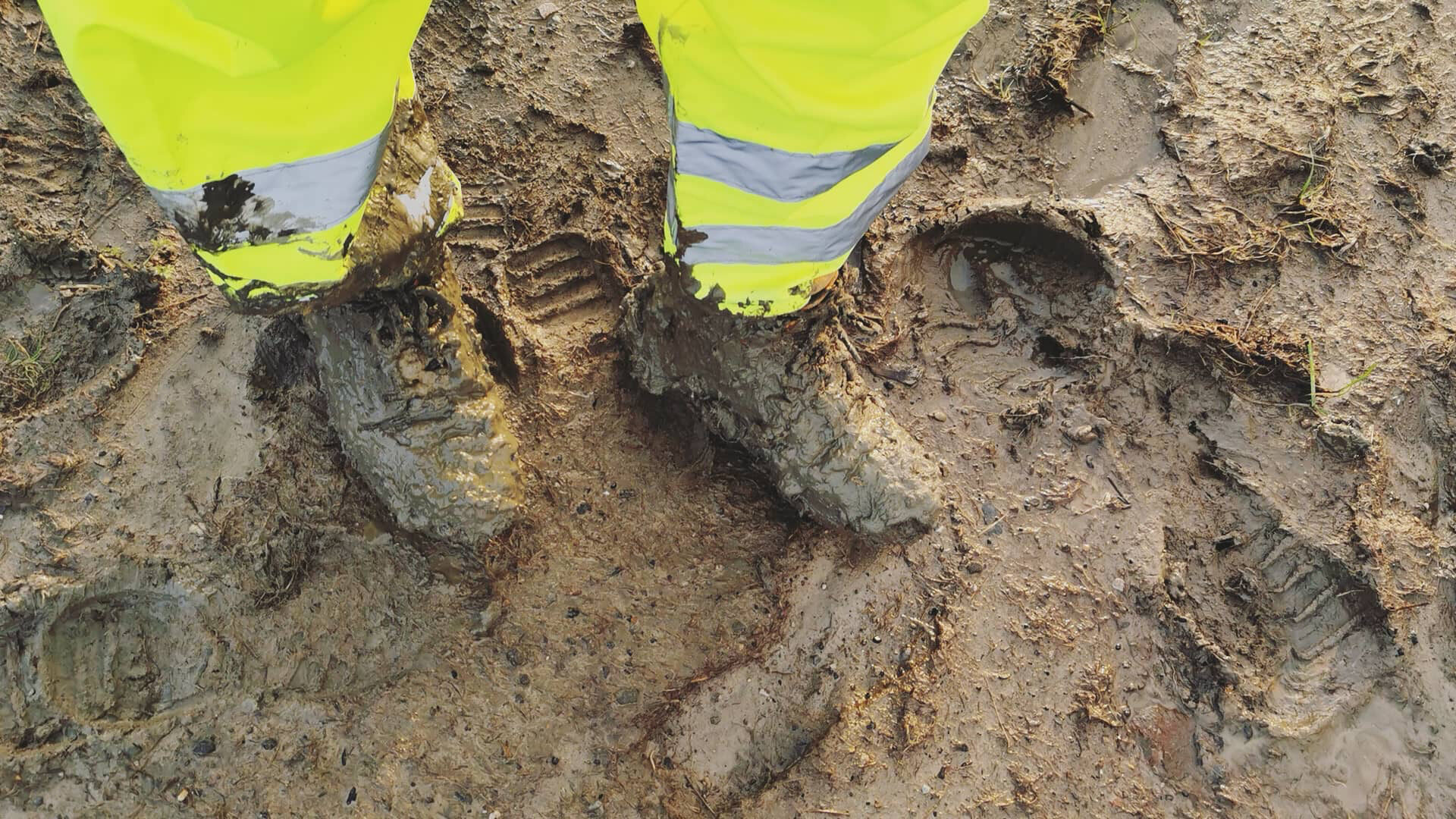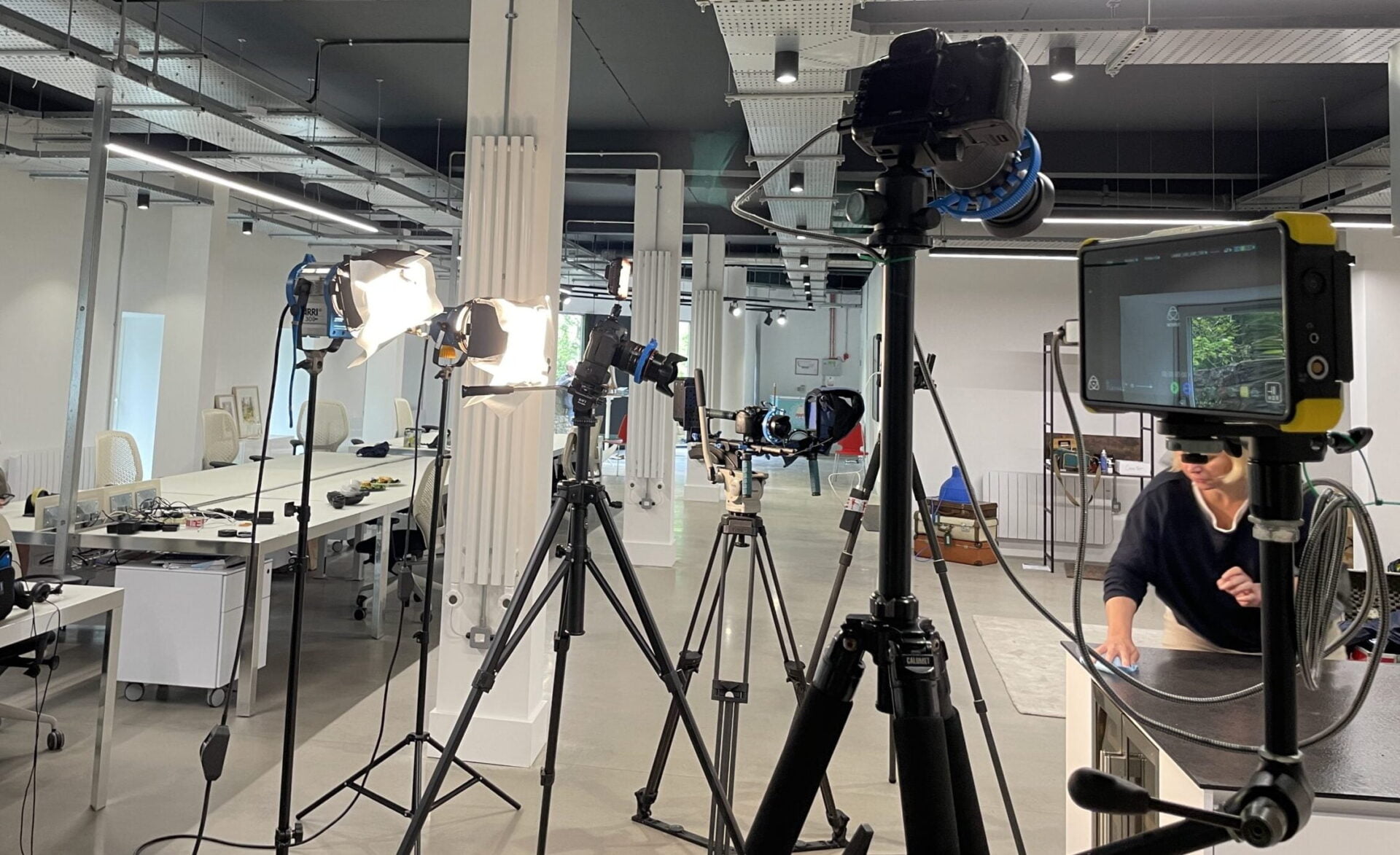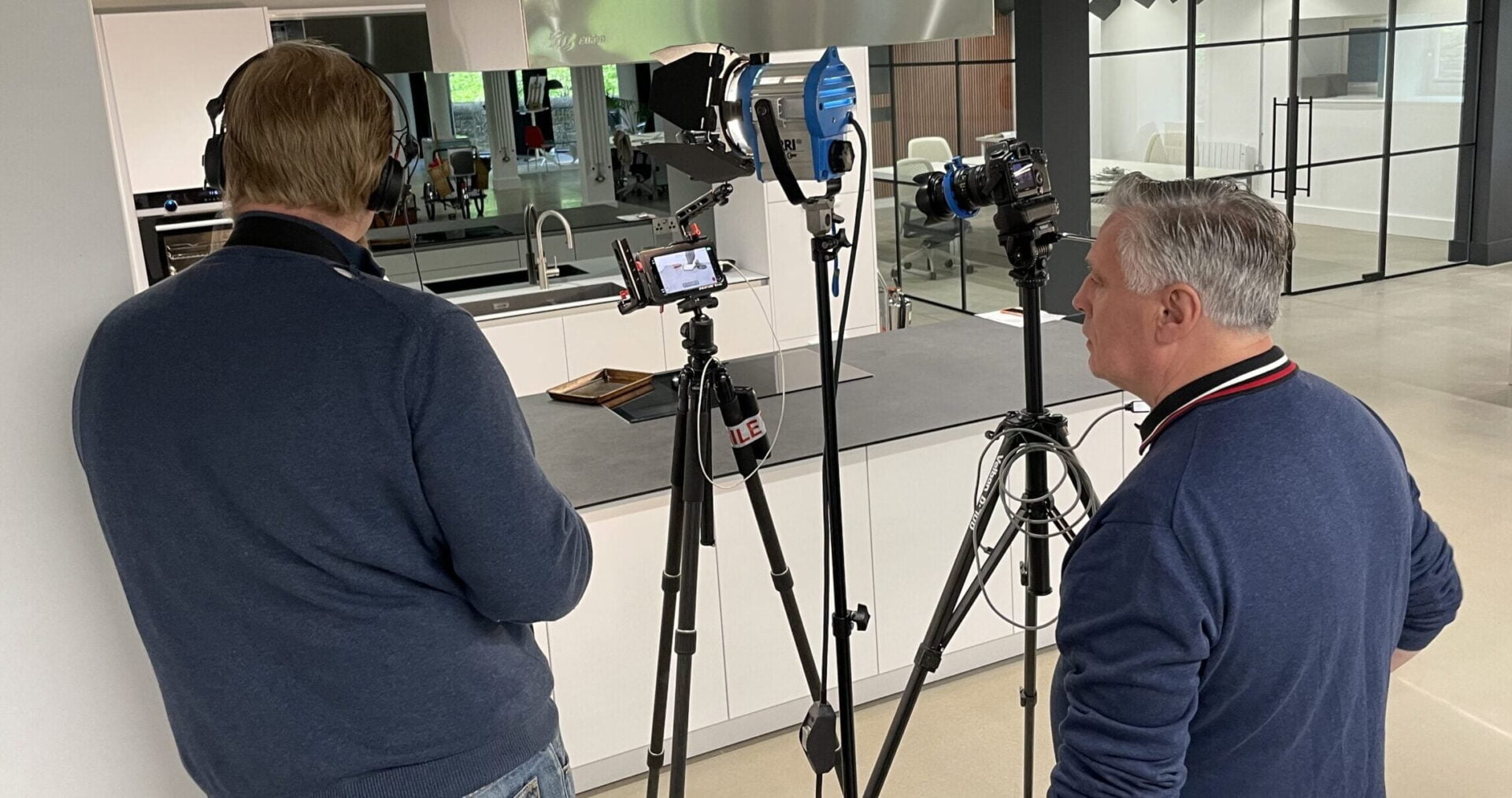Advances in technology put everything within your reach. Broadcast TV, Commercial Agencies, and Hollywood filmmakers still spend thousands, if not millions, on cameras, lighting, and sound in order to capture their films. This equipment then requires them to engage operators with extensive technical expertise and immense craft skills to operate it.
Nothing wrong in doing what they do but if you are making your first film you need to understand that this approach comes from a ‘mindset’ that stems from a time gone by where the tech meant it was the only way of doing things.
If it is still happening today it's mostly because people, inherently, still believe that - bigger budget + bigger camera + bigger crew = bigger and better film.

You, however, live in a time where advances in technology mean you can adopt a different ‘mindset’ if you want to.
Truly you only need a mobile phone to get started, because now mobile phones such as the iPhone 12 Pro Max give you four different cameras in one device, records your sound, records your footage, allows you to control the picture quality settings and they are so easy to use that you can start filming from their unboxing.
In making things easier for you, the builders of mobile phones have also made a lot of quality decisions on your behalf. Mostly, they are good decisions and produce great results with minimum effort on your part but they may not be what you want for your film.
To have more quality control and make the creative choices that you want, there are lots of options for you to consider - but only when you are ready to do so.
Quality of your picture
FiLMiC Pro is a software package that you can purchase, install onto your phone and it will give you all the manual control you will ever need; white balance, ISO, frame rates, focus, resolution, exposure settings and much more will all be under your control if you want it.

Like all software, FiLMiC Pro will take you a bit of familiarisation but for those who want to have full creative control over their shots, this learning curve is essential. FiLMiC Pro is not alone in the marketplace and you should always check out similar software to find the one that's best suited for you when making your first film.
Quality of your sound
Although the native sound recording of the iPhone 12 Pro Max is good it can be improved by adding an external microphone to your mobile phone. Make sure you have the right connector to plug your microphone of choice directly into your device e.g. with the iPhone 12 Pro Max you need to have a lighting connector on the end of your microphone lead in order to get the sound into your phone.
FiLMiC Pro has a good range of audio quality controls built into its software and these will help you capture sound the way you want them to.
Quality camera movement
Mobile phones all have built-in stabilization that helps keep things steady when you are shooting video on the move but a lot depends on just how you want to move. This is such a handy advancement for when you are making your first film.
Handheld is one way of introducing movement to your shots. It's when you are holding your phone in your hand and are simply walking around. Whether it's a short or a long walk the built-in stabilization really helps stop wobbly frames appearing in your shots. The unwanted movement in a handheld shot is often seen top to the bottom of the frame. And this is because of how our body moves when we walk.
There is a technique for walking that helps when you do a handheld shot: it's called baby steps. If you practice walking heel to toe when doing a handheld shot - you can greatly reduce the amount of stabilization support your mobile device phone will have to do.
Pan and Tilt can be done as handheld and once again things are often improved by the built-in stabilization. The better alternative is to use a phone clamp mounted on a tripod and fitted with a pan and tilt arm. Unwanted movement during a pan or tilt is very often only noticed in the edit because the screen size on a mobile phone is so small. Just know Pan and Tilt moves are very difficult to execute well and you should get lots of practice. Don’t try to learn this skill on the job.
Extremes of movement are when you might be running, on a boat, in a vehicle on a bumpy road, or other situations where the environment is introducing unwanted movement. This is when you should consider one of the handheld gimbal devices like Osmo 3 or Movi Cinema Robot. They are designed to carry your iPhone and keep things steady. While they will take a bit of practice at first - especially getting it balanced - the results are impressive. There are lots of gimbals in the marketplace so make sure you do your research to find the one that's right for you.
Remember - you only need a mobile phone to get started on making your first film!
If you have any questions e-mail us at [email protected] or call us on 0131 226 0226 to see if we can offer you support with making your first film. Also check out the rest of our website at lamedia.co.uk
You’ve got your idea, your script, cast, locations, and permissions for making your first film, now it’s time to start thinking about the equipment you are going to use to capture it.
There are three guiding factors that are significant when it comes to making your choice of equipment:
Style of shooting - camera, lenses, lighting, and sound
There is never a right or a wrong way when it comes to choosing gear to create your style for making your first film - there are only your own creative choices and ultimately they are choices that will be determined by the ‘feel’ you want your film to communicate to others and of course - your budget.
This is a very personal choice and it's one that only you as the principal creative of your film can make.
Budget limitations - hire, purchase or borrow
You can have no budget or a substantial budget - both will impact your film in the most obvious of ways.
With a budget you can hire or purchase gear and operators - without a budget, you will have to work with what you already have or borrow gear and then get friends to help.
If you borrow gear it’s a good idea to have insurance that will cover the cost of replacing things. If you use friends as crew - check their availability for your complete schedule and check their skill levels are appropriate for your filming needs in making your first film.
Operational parameters - specialist equipment
Cranes, jibs, tracks, dollies, steadicams, russian arms, and drones are just a few of the wonderful pieces of equipment that can deliver some fantastic shots that you might want for your film.
However, on location these all take time to prepare, construct and rig. They will involve more complex rehearsals, an increase in the number of filming operatives, and an additional footprint on your location that will all impact your shooting time.
There will be more mouths to feed and bodies to accommodate which can be expensive and at the end of the filming day all that equipment has to go back into flight cases - more time you will need to allow for in your filming schedule.
I’m not saying don’t use specialist equipment but challenge your own thinking. Is there another simpler way to get the shots you want? You need to think very carefully and count your money before you commit to using any type of specialist equipment when making your first film.
One Way Forward - keep things simple

The most simple setup for filming involves just one camera, one lens, one tripod, an ability to record independent sound and natural light.
Camera
A DSLR or mobile phone is a great place to start when it comes to cameras. Most of us have one of either and are already familiar with how they operate and what they can achieve.
Lenses
 If you have only one lens in your kit you will learn very quickly how to move and reposition the camera to get the shots you want. There is no danger to having more lenses but know that any lens change on location will take time.
If you have only one lens in your kit you will learn very quickly how to move and reposition the camera to get the shots you want. There is no danger to having more lenses but know that any lens change on location will take time.
Tripod
A tripod is your steady platform for shooting. Usually, they are readily available with either a ball head mounting or a pan and tilt head option. Both these heads will let you set and adjust your shots.
Lighting
Try to use available location lighting especially even when shooting at night. Daylight is great but when things get a dark look around and find spots that are already lit.
Street lights, shop window lights, car lights try to use anything you can to avoid having to carry specialist lights. If it means adapting your scripted action to benefit from your location's available lighting then it's usually a good idea to do so.
Sound
DSLR cameras and mobile phones have integrated microphones for recording sound but they are not the most flexible of options. If this is all you have to work with then find the best way to use them.
If options are available to you, consider getting hold of a directional microphone, boom-mounted with an XLR cable connection to an independent audio recorder.
DATA
DSLR cameras use flash cards with various write speeds and storage capacity while mobile phones use internal storage to record your first film. Make sure you have enough of both to avoid time not filming because your data is being transferred. Data transfer just takes the time it takes and is best done during filming breaks or at the end of your shooting day. You must plan for them as they will have to happen at some point.
Keep an eye open for our Part 4 in this 'making your first film' series where we will get into how ‘Advances in technology have changed everything’
Meanwhile, if you have any questions e-mail us at [email protected] or call on 0131 226 0226 to see if we can offer you support with making your first film Also check out our other blogs and visit the rest of our website lamedia.co.uk
In Part 1 we explored the first half of the prep required if you want to be making your first film so in this, Part 2, we are going to briefly explore locations and permissions as you journey to the point where you can take a deep breath, and go and start shooting your own movie.
Overview

At this point on your journey of making your first film, you should have your script ready or even just have a flushed out form of your idea.
From these, you should identify the type of locations you will need for your film and have noted what time of day each location is to be featured.
You can then break things down even further by identifying which scenes happen at the same locations and detail which cast members, props, crew, and equipment are required to be at any location on any day. This will help immensely when it comes to scheduling your shoot cost-effectively.
Now all you have to do is find your locations, get permission to film there and then start creating your own shooting schedule.
It’s now that you should also start to flush out health and safety assessments based on any potential hazards you may find on your locations (more to come on health and safety in a further blog).
NB. a negotiable fee will often be required to be paid for the use of any location and if it's too expensive, simply find another.
Finding a location
Sometimes this can be done virtually on Google Earth otherwise it will involve a team to physically visit prospective locations. This is called a recce.
Once there, you are principally going to be considering creative suitability but it's also important that you look at issues of practicality.
Traffic, extraneous noise, people ingress, parking, toilets, where to lunch, how much impact your unit will have on the location, and how much impact the location activity will have on your filming - just a few things to think about that might make a difference as to how smoothly your filming goes.
Permission
By getting permission to use a location you can have the confidence required to start making your first film. Without permissions, there is the underlying stress of your unit being challenged on arrival and potentially being sent packing by an angry property owner.
Start with any local film authority that is available in your filming area. Contact them and let them know what you are planning to do. These are the local filming specialists who will keep you right, put you in touch with police, traffic control, event departments, and a lot more people who would like to know:
a. what you are doing,
b. when you are planning to do it
c. how can they help
The people who work in these departments are a useful and cost-free asset you really should take advantage of. They are usually very experienced in what they do and will always want to help you succeed. I would strongly advise you to get them on board with your filming at your early planning stages.
Just go commando
There is a school of thought that says ‘just go commando’ which means ‘shoot it as you see it’ with no permissions in place. While a small team with light gear can sometimes get away with this approach, it is a high-risk strategy.
Generally, there will always be someone who will spot you working on a location and then ask you the killer question ‘have you got permission to be filming here?’. If your answer is no - that's usually the start of distracting discourse which often ends your filming effort at that location.
Filming Schedule
Having found your locations and got your permissions you now need to identify the production effort for each by putting locations, dates, times, cast members, and props into a filming schedule form.
Any information that you feel is critical to your team working effectively should be included in your filming schedule. This document can then be shared with everyone on the team to ensure they know your plan and that they are all working off the same page.
Each production will produce its own version of a film schedule and the amount of detail included is always subject to how many people and how much effort you can throw at it.

The useful information you can add to a schedule is almost endless but you must consider how much time and effort you have available to do this.
The true effectiveness of your filming schedule will rely on you having a good knowledge of the availability of locations being matched with cast, crew, and equipment.
It will require you to have an understanding of time management regarding travel, breaks, and how long it might take to film scenes.
A typical question to ask yourself is ‘how long does it take to get a cast member to a location, into make-up then wardrobe, and finally out in front of the camera ready for filming’ and then ask yourself ‘should I allow time for a chat, a quick coffee, a breakfast, or a simple weather delay?’.
There are hundreds of things that can throw your schedule off course and while you can never anticipate them all you should make sure your plan allows for the unexpected before you start making your first film.
Keep an eye open for our Part 3 in this series on ‘making your first film’ where we will get into ‘The gear you need to make your own film’.
Meanwhile, if you have any questions e-mail us at [email protected] or give us a call on 0131 226 0226 to see if we can offer you support with making your own film. Also, don't forget to check out the rest of our website at lamedia.co.uk
You’ll probably want to know what being on set is actually like after you’ve read LA Media blogs like “How to kickstart a career in television” or “So You want to be a 'Runner' in television or film” previously.
My name is Annie, I've worked as a camera assistant/runner with LA Media on various sets for a year now and I've been given the honour to share my experiences and thoughts on what being on set is like and how you can make your experience make a change for you and the rest of the crew.
The simple answer to "what is it like"? No one day is the same on any set. In my personal experience working on different projects with LA Media, we could be trying to silence our rumbling stomachs, filming a chef prepare a three-course meal one day and literally knee-deep in cold mud on a windfarm the next. I think that’s the appeal to the job and the thing that makes me excited to get up at unsocial hours of the day to get to set on time.
Make yourself useful
The main thing I’ve learned from being on set with LA Media is the importance of thinking ahead and seeing where and what you can assist with. In other words - making yourself useful.
Small things like double-checking battery levels, keeping an inventory of all the bits and pieces of the kit in your head or almost reading your crewmates' mind and knowing what they’ll need passed to them before they ask can be game-changing.
There shouldn’t be a moment in your day on set where you think there’s nothing else to do or help with. Keep it moving, but remember to watch your feet while pirouetting between tripods, cables and lights!
Watch and listen
I’ve stressed the importance of the team having something to gain from you being on set. Now let’s discuss what there is for you to gain from the experience.
I would say that it’s in your own hands to make each day on a set matter to yourself. When I’m on set I keep my eyes and ears peeled to everything that is going on around me. Be it a tidbit of information about a new piece of kit or watching the director communicate with the client or talent.
Everything you see or hear will prove useful to you at work in the industry or when someone mentions windfarms in a conversation at the pub for example.
Don’t be afraid to ask questions. As cliche as it sounds, there really are no silly questions, especially in an environment of creatives in their natural habitat. How else are you going to find out and learn??
It’s really up to you to be proactive about putting everything you hear and see on set to use further in your life and career.
Communicate
As with all teamwork, communication is key. I know I mentioned mindreading previously, but I am yet to meet a crewmate that can actually read minds when it comes to how you feel or what you think.
Do not suffer in silence. Tell someone if you have a sore head or you’re not in a good place emotionally for example. Trust me when I say it will bubble up and ruin the day on set for everyone in that team if you’re walking around with a dark gray cloud above your head.
You should feel comfortable talking to your teammates when it comes to creative decisions too.
Your input matters
We all see the world from different angles so it’s important for you to make suggestions if you see a shot that could work better for what you’re trying to achieve on set that day. You’re not questioning the director’s decision or authority, you’re simply and politely giving a different perspective. Even if your idea doesn’t stick then, it might inspire one later. You’re in a room full of creatives, those brains should be working overtime.
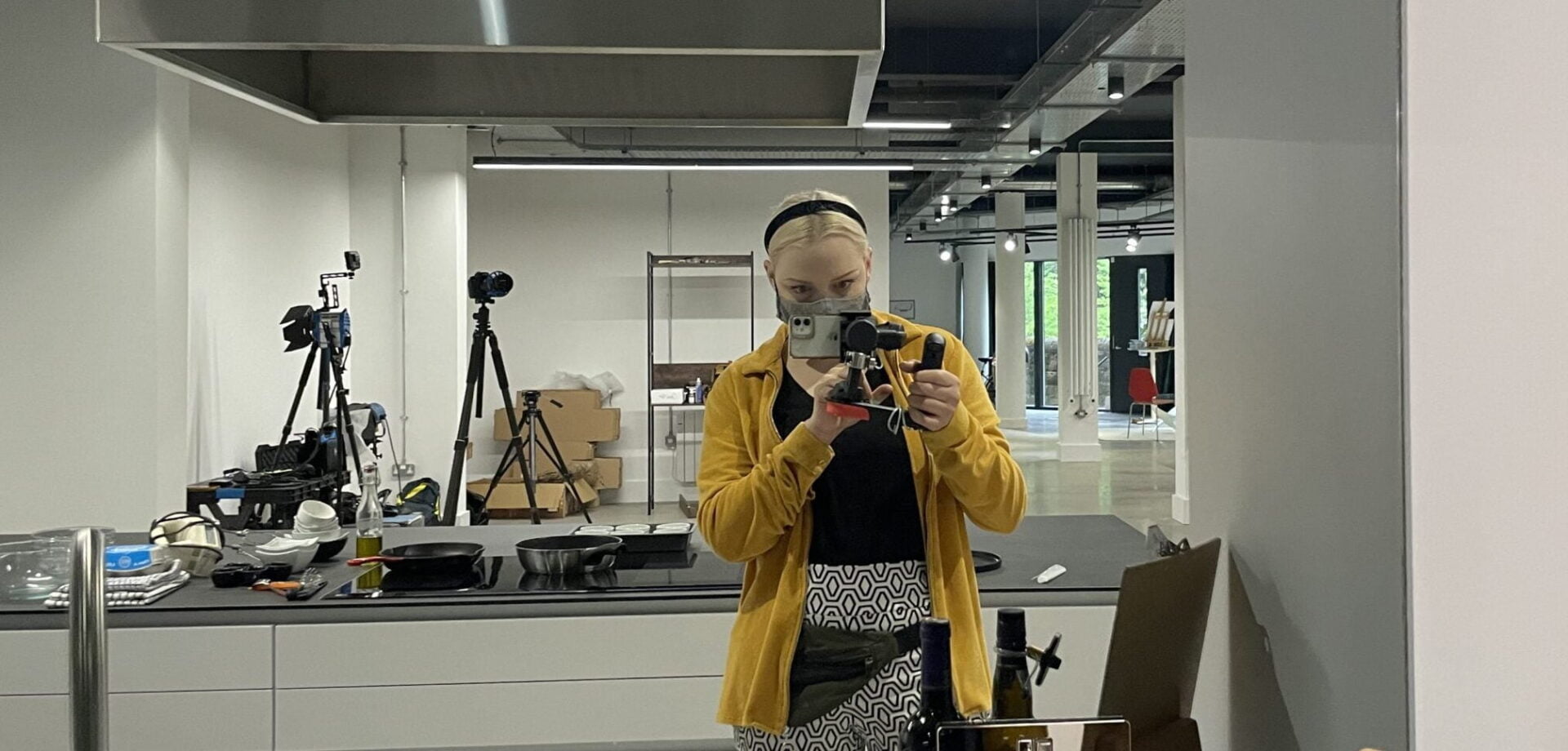 Make the most of your time on set, there really isn’t a more dynamic and fun environment to work in. I am glad I’ve had the opportunity to take part in creating some top-notch material with LA Media. I look forward to work on more in the future.
Make the most of your time on set, there really isn’t a more dynamic and fun environment to work in. I am glad I’ve had the opportunity to take part in creating some top-notch material with LA Media. I look forward to work on more in the future.
Check out the rest of our website and if you have any questions e-mail us at [email protected] or just give us a call on 0131 622 0220.
If you enjoyed this blog don’t forget to follow us on: Twitter, Facebook, and Instagram for your daily dose of media & drone chat!
I have loved every minute of being an iPhone 12 Pro Max owner. It's got a great screen, it's super-fast, looks extravagant, and is a mighty computer that easily fits into your pocket.
Sometimes I simply enjoy looking at it in all of its awesomeness but then I get reminded that there is one drawback…not everyone has one.
When I bring it out of my pocket I get inundated with questions from the ‘iPhone 12 Pro Max Curious’. This is what I’ve decided to call people who want this newest iPhone but need some answers before they buy and therefore insist on asking me the same questions over and over again.
So if you are one of the ‘Curious’ I've made things easy just for you and hopefully saved you the trouble of revealing this to others. Here, just for you, are the ten most frequently asked questions I get and the answers I give.
Enjoy!
What colours does the Apple iPhone 12 Pro Max come in?
Silver, Gold, Graphite, and Pacific Blue.
Does the Apple iPhone 12 Pro Max support 5G?
Yes - in fact, all four models of the new iPhones 12 support 5G
Does it have USB-C?
No - it still uses a lightning port and will continue to do so for at least another year
Does the iPhone have a headphone jack?
No - Apple hasn’t supported headphone jacks on its phones for years

Does the Apple iPhone 12 support wireless charging?
Yes - It comes with the new MagSafe feature with up to 15W wireless charging
Does it have dual-SIM capabilities?
Not for most of us - The iPhone 12/12Pro line-up supports one physical SIM card in addition to one eSIM card, however, it's worth noting that eSIM support is still pretty spotty across carriers.
The only exception is in mainland China, Hong Kong, and Macao, where dual sims are supported in iPhone 12 models. By placing one sim on the top of the sim tray and the other underneath you can get dual sim functionality in these regions only.
Does the Apple iPhone 12 have a microSD card slot?
No - iPhones have never had one. You can of course get various dongles that allow you to use SD and Micro SD cards with your iPhone.

What memory does it have?
The iPhone 12 Pro Max comes with 6GB of RAM and the option of 128, 256, or 512GB of internal storage
 Plenty of storage on here!
Plenty of storage on here!
Does the iPhone 12 Pro Max have stereo speakers?
Yes, the iPhone 12 has two speakers (earpiece/bottom-firing) that generate high-quality stereo sound.

Surprisingly good sound!
Should I buy one?
OMG….of course you should!

Well, there you have them. my top ten questions and answers. I suggest you keep a copy of these on your iPhone if you decide to buy one, as these are the same questions you will face from others as they start to reveal themselves as the ‘iPhone 12 Pro Max Curious’.
Keep your eye on our blogs and our YouTube as we aim to explore the video potential, the add ons, and the cinematic software available for this outstanding platform.
If you’d like to get some more buying advice or simply want to check out what we do here at LA Media, why not get in touch via our website at lamedia.co.uk or give us a call on +44 (0)131 622 0220.
Before we talk about the Amazon Echo Plus, a few words on the previous model. The original Amazon Echo was first introduced to Prime members in November of 2014 and came to everyone else in the UK in September 2016. The Echo Alexa was designed to answer your every beck and call. Whether providing information such as the latest news and weather, adjusting your heating, or controlling your AV system, Amazon’s Echo speaker promised to do it all. And it did. For the most part, but initially relied heavily on third-party apps and hardware for integration into your smart home. Now there is a new generation upon us.
As well as the Dot, there is now an Echo 2, Echo Plus, Echo Show, and Echo Spot. What we’ll focus on here is the Echo Plus. I actually originally got the Echo 2 but swapped it for the Echo Plus. I’ll explain my reasons later. Essentially the Echo Plus looks more or less the same as the original Echo. It now has a 3.5mm output on the back, however. This means you can plug it into more expansive audio systems and have Alexa controlling your existing speaker set-up.

Features
The main difference between the Echo Plus and the original is the built-in smart hub. This means you can connect your Philips Hue lights directly to the Echo Plus. Nice right? There are still some limitations, but I'm fairly sure these will be addressed soon. In fact, Amazon seems to update Alexa at an alarming rate… The dawn of Skynet perhaps?
I’ve already found a bath that will run itself... If you already have most of your smart devices set up (like I do) then you probably won’t benefit too much from the built-in Smart Hub. Apart from controlling your home, there are many other thing s Alexa will do for you. The new ‘Drop in’ feature is pretty cool and slightly freaky. When away from home or in the home you can connect to any Alexa device and speak to the (slightly terrified) person at the other end. There’s the music as well… Echo devices come with a limited, reduced price version of Amazon music. I’d recommend upgrading to Amazon Music Unlimited at least.
Sound Quality
This for me is a biggy. I originally bought the Echo 2, but having set it up and so on, wasn’t that impressed with the sound. Lacklustre bass and not very clear highs made this not very impressive to listen to. It was all midrange. I know the Echo range is primarily about Alexa, and that, they do very well. But I wanted at least the best sound I could get whilst enjoying the abilities of Alexa. So I upgraded to the Echo Plus. It’s definitely an improvement. A little more bass (depending on where you’re standing in the room) and much better clarity up high. Plus, I think it looks much better.
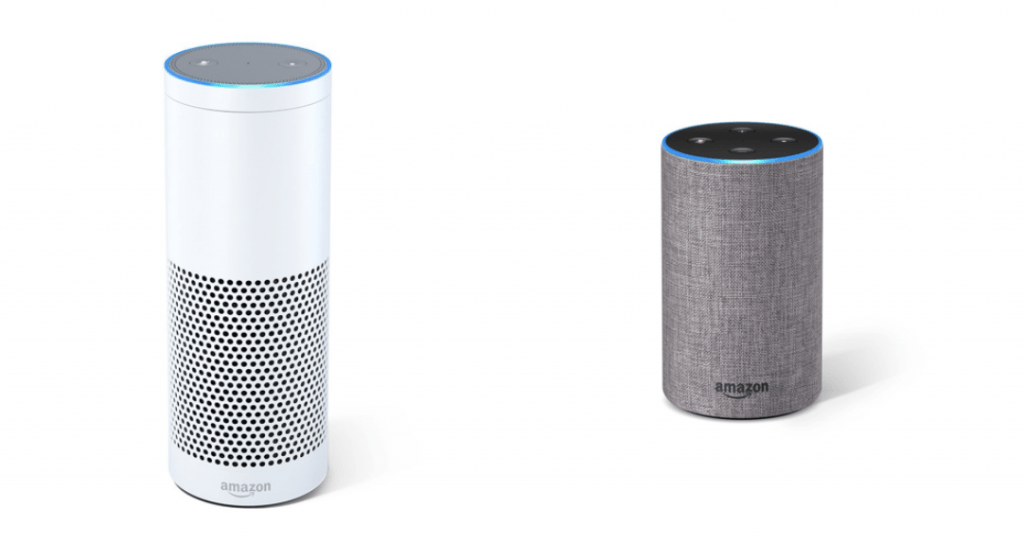
They come in different colours. For the Echo Plus, it’s Black, Silver and White. for the Echo 2, you have Charcoal Fabric, Heather Grey Fabric, Oak Finish, Sandstone Fabric and Walnut Finish.
Verdict
So in summary… If you’re looking for a good speaker first and smart abilities second, this perhaps isn't for you. Sound quality is not nearly as good as a Sonos One for example. As much as you can plug it into an AV setup, you would be better off getting an Echo Dot for that, which is only £39 at the moment.
I think this makes the most sense in the kitchen. The sound is good enough for most, and the Alexa functionality and voice recognition works very well. Much better than the new Sonos One. Amazon is constantly updating their Alexa skills, so it’s more than likely that any smart devices you have, will work with Alexa. I have the TV/Apple TV - via Logitech's Harmony Hub and controller, Heating - via Nest, all the lights - Philips Hue and various Wemo smart plugs for power-hungry devices all working with Alexa. It takes a bit of faffing around with at the start, but now all works brilliantly.

Would I recommend this? Yes, I would. Great for the kitchen, and if this is your first foray into Alexa, you’ll have countless hours of enjoyment asking her ridiculous and useful things. At this point, Alexa is definitely the best smart assistant out there and in the Echo Plus, she is at her best.
Visit our website lamedia.co.uk and if you have any questions or think we got something wrong or simply want to let us know what we missed... e-mail us at louise@lamedia.co.uk or give us a call on 0131 622 0220
Highland Spring's online content has been going through a phase of redesign and growth. Recently, the well-known bottled water brand, in partnership with the Lawn Tennis Association refreshed their packaging, which went live in April of 2017.
LA Media was thrilled to be asked back to film Highland Springs' latest online content. This content was to consist of a series of short videos, which would support their new theme and message of Brave by Nature.
After Highland Springs' highly successful and adrenalin-packed ' The Chase' video, for which LA Media provided the drone footage, they decided to follow it up with a series of web videos to be shared on their website and social media platforms.
The films were to be quite different from the James Bond-esque video that saw a man leaping off a cliff onto a moving train! These online videos were intended as light entertainment, featuring kids of varying ages answering questions about 'water' and what bravery means to them. No CGI, no stuntmen, and certainly no train jumping.
Working on 'Kids on Hydration' online content
Screen-Grab from Highland Springs' Online Content
The title of the project was 'Kids on Hydration' and was created by Edinburgh digital agency Whitespace. Whoever said "never work with kids" has obviously never met the fabulous children we worked with on this project.
The kids from The Drama Mill and Skool Is Out were amazing and their answers to the questions were so varied - factual, hilarious, surreal, honest, and random. It was great to hear their opinions on what it means to be brave amongst other things.
Screen-Grab from Highland Springs' Online Content
Initially, we were invited to do 3 films but ended up doing 12 - we had filmed so much fantastic content it would have been a crime for it to end up on the cutting room floor.
An Example of the questions put to the kids
LA Media is very experienced at working with young talent and creating the right atmosphere for the filming to work. We wanted it to be as fun as possible and give the kids the space to voice their opinions.
The main goal of the films was to capture the variety of the children's responses in a snappy, entertaining and lighthearted way and we think we definitely captured this vibe. See our video below and see what we mean!
The final product is now live on Highland Spring's Instagram, Facebook, and Twitter. It has received an overwhelmingly positive response from viewers and we are extremely proud to have been part of this project.
CREDITS:
Client: Highland Spring
Agency: Whitespace
Production: LA Media
Director: Jude Lightbody
DOP: Andrew Murray
Sound: Robert McDougall
Original Music: LA Media
Talent: The Drama Mill & Skool is Out
We hope you enjoyed this and maybe got a little inspired!
Visit our website lamedia.co.uk and if you have any questions, e-mail us at [email protected] or give us a call on 0131 622 0220
Over the past fifteen plus years, LA Media has been lucky enough to have had the privilege of filming Scotland and its most beautiful and iconic locations. From Unesco World Heritage Sites to hidden coves on the Isle of Skye, we've been pretty much been everywhere thanks to our busy production work schedule. Often we feel like the joy of 'filming Scotland' is a well-kept secret. Even agencies in London don't realise the filming potential they have sitting on their doorstep!
LA Media was one of the first production companies in Edinburgh to embrace the potential of drones and aerial filming for production. We were early adopters of this technology, so we've got a pretty extensive showreel of aerial footage of Scotland. With this series, Scotland in Motion, we'd like to share some of our best experiences of drone filming experiences.
Scotland in Motion - Our Ode to Drone Joy
Scotland in Motion is LA Media's own personal ode to joy, which celebrates Scotland's epic landscapes and locations. It's a series of short clips that highlight some of Scotland's most iconic locations. Below we'd like to share with you our first five instalments of filming Scotland! All footage, post-production and original music were created in house by the LA Media team.
St Andrews Rippling Waves
In this video, LA Media sent its drone soaring over the rippling waves of St Andrew's historic coastline. In this video, you'll see Scotland's glorious sunshine gleaming like gold on the sea-green waves of the North sea.
Dunnottar Castle
Enjoy some dramatic drone footage LA Media filmed of Scotland's Dunnottar Castle. Located on the edge of the North Sea, the ruins of this historic and once impregnable Scottish cliff-top fortress are uplifting and provide food for the imagination. We've paired the footage with some appropriately dramatic music!
The Highlands
In this video, you'll soar over the rugged mountains of the Highlands. The lush verdant colours of Scotland's landscape and clear skies make this one of our favourite locations. It's hard to feel anything but wowed when you watch this.
Duns Castle & Glen Etive
We hope you enjoy our drone footage of the hauntingly beautiful Glen Etive, which you'll recognise from movies such as Skyfall and Braveheart. Then join us in the Scottish Borders to admire the stunning Duns Castle, which is steeped in over 300 years of Scottish history.
Crawick Multiverse
Have you seen the Crawick Multiverse? It's a stunning globally-renowned landscape in Dumfries and Galloway. Come fly over this inspiring landmark with the LA Media drone team.
Filming Scotland
Scotland is arguably one of the most beautiful places on Earth to film. With its natural beauty, unspoilt rugged landscapes, its abundance of historic castles and stunning cities Scotland is just a fantastic place to film. Due to its unbeatable locations, Scotland has provided the setting for a number of high profile films over the last few years including Fast and Furious, Cloud Atlas and The Dark Knight Rises.
It is no wonder that in recent years there has been an upsurge in the number of productions opting to come to Scotland to film and taking advantage of our jaw-dropping locations. Scotland’s film industry has evolved dramatically over the last decade and now boasts a cinematic repertoire that attracts some of the biggest names in the business including productions featuring Brad Pitt, Scarlett Johansson and Daniel Craig.
We hope you enjoyed this and maybe got a little inspired! We hope you enjoyed this blog post. Don’t forget to follow us on: Twitter, Facebook and Instagram for your daily dose of media & drone chat!
Visit our website lamedia.co.uk and if you have any questions, e-mail us at [email protected] or give us a call on 0131 622 0220
LA Media is very proud to be a part of the team bringing this new 'Bounce It' app to a phone near you! So you may be wondering "how exactly does one Bounce it? " Well, keep reading to find out...
Bounce It is a fun new social media app that is based on the theory of six degrees of separation. Basically, this is the notion that you can be linked to anyone in six steps or less. Excuse us while we figure out how we are six steps away from Beyonce....
Video by LA Media "Bounce It App Video"
So What is Bounce It?
Bounce It lets you bounce content from user to user. Using GPS the Bounce It app can track the path of your content as it travels around the world.
Users will also be set challenges when they sign up to the app, such as trying to get an image viewed on every continent in the world.
Image by LA Media 'Meet Pogo!'
Leaderboards will show you and all your friends who create the most content, who has their content shared the most and who’s content travels the furthest. Every time your photo travels to a new country, you get that countries flag on your profile, so get collecting!
What Part Did We Play?
LA Media went to meet Bounce It’s creator, entrepreneur Jack Francis to find out exactly what the, as then unreleased, Bounce It app did.
We then proposed a creative treatment built around using existing brand elements to produce an animation. That way we could create a Bounce It world to introduce this new way of sharing and tracking media.
The creative treatment principally involves bringing to life the character ‘Pogo’. Even in a still form, we felt he had oodles of personality and was begging to be animated.
Image by LA Media ' Bounce It can track the path of your content as it travels around the world.'
We then looked at the icons and shapes that would populate Pogo’s world and determined his bouncing movement to reflect the idea of bouncing media and connecting people globally.
LA Media’s Creative Producer, Jude Lightbody scripted and storyboarded, working alongside our friends at Interference Pattern, to produce the animation.
Creating the Right Vibe
The music bed was fundamental to the animation - setting the tone it had to be positive, upbeat, friendly, fun, and full of energy. Mike Jameson, LA Media’s editor, and composer composed and produced the music, and the final animation was brought back in-house to LA Media for voice-over, audio dub, and delivery.
Great fun and the app is now available on Google Play and the Apple Apps Store. So come on people - Share Your World, Track Your Journey!
See the full video now and let us know what you think!
We hope you enjoyed this blog post! Don’t forget to follow us on: Twitter, Facebook, and Instagram for your daily dose of media & drone chat!
Visit our website lamedia.co.uk and if you have any questions, e-mail us at [email protected] or give us a call on 0131 622 0220

